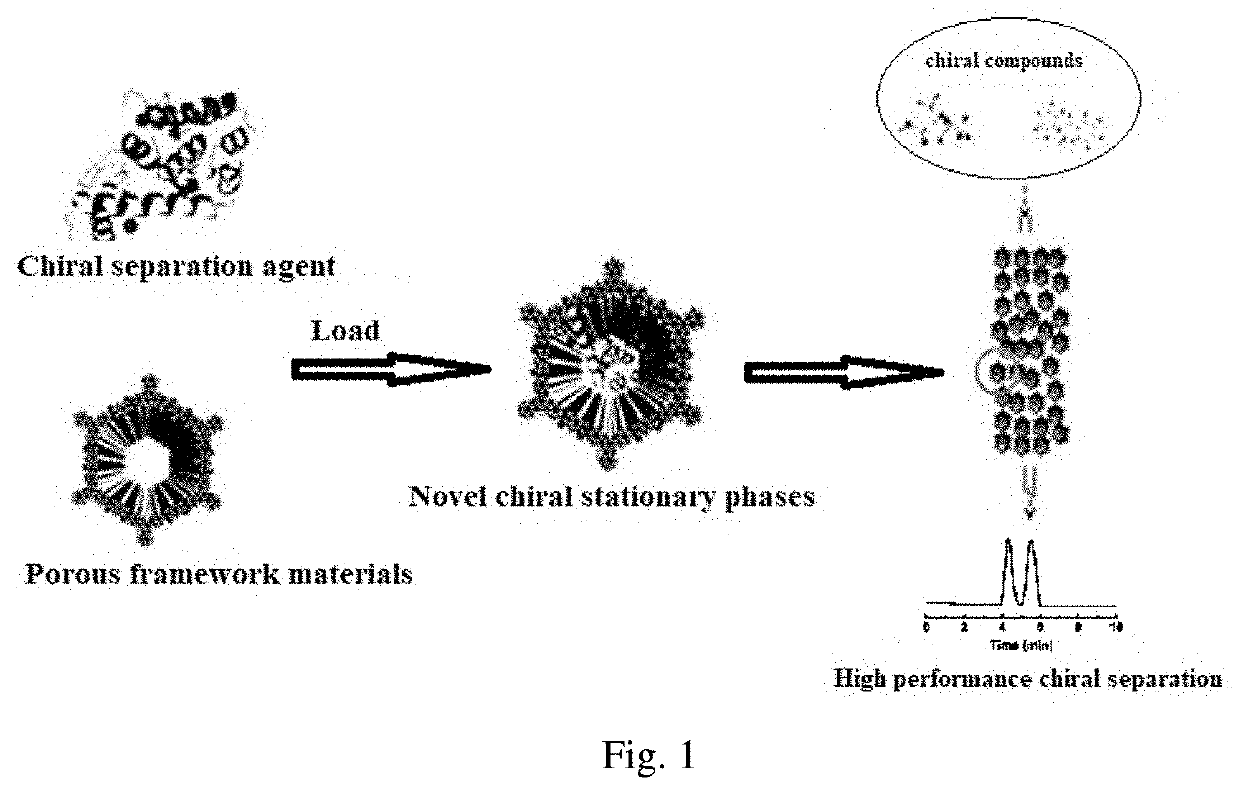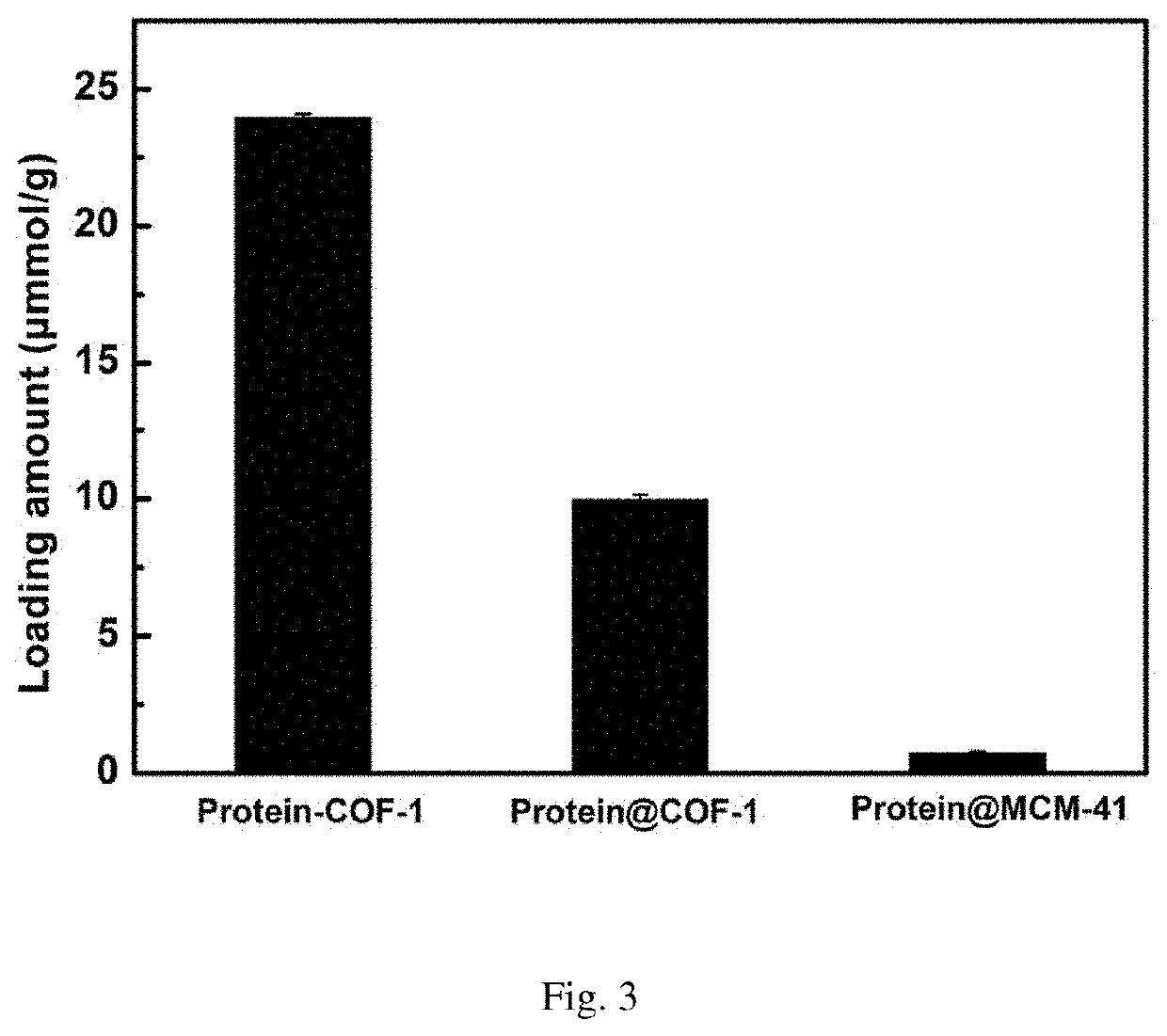Preparation of chromatographic stationary phase having porous framework material as matrix for chiral separation
a technology of porous framework material and chromatographic stationary phase, which is applied in the field of chromatographic chiral separation, can solve the problems of significant differences in biological activity, metabolic process and toxicity of enantiomers with different optical activity, and no report about their application in chiral stationary phase carriers, etc., to achieve the broad scope of separable substrates and the applicability of such technologies, and improve stability. , the effect of small sample volum
- Summary
- Abstract
- Description
- Claims
- Application Information
AI Technical Summary
Benefits of technology
Problems solved by technology
Method used
Image
Examples
embodiment 1
s of Covalent Organic Framework COF-1 that Used for Covalent Bonded Chiral Resolution Agents, the Specific Steps are as Follows
[0049]The ligands 1,3,5-tris-(4-aminobenzene) triazine (TAPT 0.10 mmol) and pyromellitic acid tincture (PMDA 0.15 mmol) were added to the thick wall glass tube (O.D.×I.D=10×8 mm2), then 0.5 mL mesitylene, 0.5 mL N-methylpyrrolidone and 0.05 mL isoquinoline were added, frozen rapidly in liquid nitrogen, vacuumized, and then sealed with hydrogen oxygen machine flame. The sealed glass tube was put into an oven at 200° C. for 5 days to react, and then yellow solid product COF-1 was obtained.
[0050]Solvent Activation of Porous Framework Material COF-1:
[0051]The obtained solid was washed several times with anhydrous tetrahydrofuran, until the supernatant was colorless. Then 100 mL anhydrous tetrahydrofuran was used as solvent of Soxhlet extraction for 24 hours, and the yellow solid was activated at 80° C. under vacuum for 8 hours, and then the product was stored in...
embodiment 2
anic Framework COF-1 as Carrier for Covalent Immobilization of Enzyme
[0052]Activation of Carboxylic Acids in Covalent Organic Framework COF-1.
[0053]Weigh 10 mg of COF-1 to 20 mL of glass reaction bottle, add 5 mL of MES buffer solution containing equal amount of EDC and NHS, shake in the shaker at room temperature for 2 hours, then filter out COF-1, and wash 3-5 times with 5 ml of MES buffer solution of 0.1M pH 6.0, and then dry at room temperature.
[0054]Covalent Immobilization of Enzyme on Activated COF-1.
[0055]Weigh 10 mg activated COF-1, add into 20 mL glass reaction flask, then add 2 mL of MES buffer solution containing 3 mg / mL of enzyme to the vial, shake in the shaker at 37° C. As shown in FIG. 1, the ultraviolet absorption of supernatant is tested every other period of time to calculate the amount of enzyme loaded on the material, and the covalent immobilization curve of enzyme into COF-1 is drawn. FIG. 2 is the final loading amount of enzyme on the material after 24 hours.
[0...
embodiment 3
obilization of Vancomycin with Covalent Organic Framework COF-1 as Carrier
[0058]Covalent Immobilization of Vancomycin on Activated COF-1.
[0059]Weigh 5 mg of activated COF-1, add into 10 mL of centrifuged tube, then add 2 mL aqueous solution containing 5 mg / mL vancomycin to the centrifuged tube, shake it in a shaker at 37° C. As shown in FIG. 3, the ultraviolet absorption of supernatant is tested every time interval to calculate the vancomycin content loaded on the material, and the covalent immobilization curve of vancomycin by COF-1 is drawn.
Embodiment 4: The Synthesis of the Covalent Organic Framework COFTTA_DHTA
[0060]The ligands TTA (0.05 mmol) and DHTA (0.075 mmol) were weighed respectively and added to the thick wall heat-resistant glass tube (O.D.×I.D=10×8 mm2), then 0.5 mL mesitylene, 1 mL 1,4-dioxane and 0.1 mL 6 M acetic acid were added, frozen rapidly in liquid nitrogen, vacuumized, and then sealed with a hydrogen oxygen machine flame. The sealed glass tube was put into a...
PUM
| Property | Measurement | Unit |
|---|---|---|
| Nanoscale particle size | aaaaa | aaaaa |
| Fraction | aaaaa | aaaaa |
| Dimensionless property | aaaaa | aaaaa |
Abstract
Description
Claims
Application Information
 Login to View More
Login to View More - R&D
- Intellectual Property
- Life Sciences
- Materials
- Tech Scout
- Unparalleled Data Quality
- Higher Quality Content
- 60% Fewer Hallucinations
Browse by: Latest US Patents, China's latest patents, Technical Efficacy Thesaurus, Application Domain, Technology Topic, Popular Technical Reports.
© 2025 PatSnap. All rights reserved.Legal|Privacy policy|Modern Slavery Act Transparency Statement|Sitemap|About US| Contact US: help@patsnap.com



